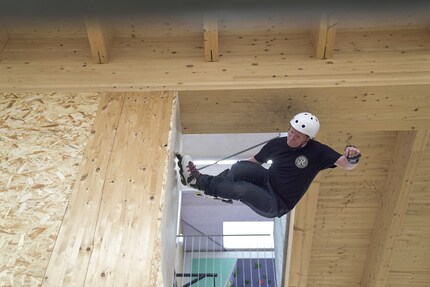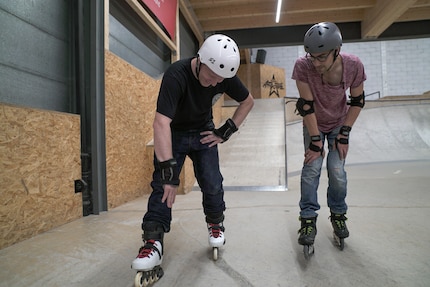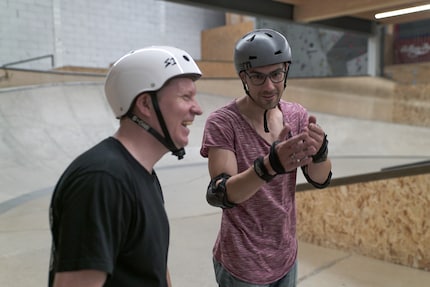
Background information
Car vs. inline skates: racing through Zurich, part 2
by Simon Balissat
Driving? Went. Braking? Not at all. My first appearance on inline skates was improvable. Community member Martin Bommeli took pity on me, invited me to a braking course and showed me how to do it properly in the video.
The day came sometime in spring when I was declared a skater. "We're having a race: SUV versus rollerblades. Simon Balissat against Michael Restin." It was written there in black and white. Nobody really took my concerns seriously because I hadn't skated for about fifteen years and was more of a rollerblading type anyway. At least the route was adjusted slightly to increase my chances of survival. Then I was allowed to torture myself across Langstrasse with a unicorn on my helmet.
It was a close race, but not a pretty sight for skaters and aesthetes. Simon's bricklayer's décolleté was pixelated, my inability could not be concealed. My signature move in particular, the stumbled death spiral brake, was difficult for a user to bear.

Well, yes, I had rollerblades on my feet. But it wouldn't have looked any better with other inline skates. Acquittal for all the blades and skates in the world. I messed up out of incompetence and am happy about the offer.
A few emails and a few weeks later I'm at Rolling Rock Aarau, where Martin Bommeli works as an inline skating instructor. Martin is 33 and has put his IT career on hold because skating is his passion. He has been giving courses since he was 16. That sounds good. In the past, especially in aggressive inline skating. That sounds dangerous. But of course someone like him masters the basics in his sleep and now he teaches everyone. Whether big or small, good or bad. So let's do the braking course once, please! You can watch it in the video above, more tips can be found in the text.

After a few warm-up laps, we start with the simplest technique imaginable. Roll slowly, spread your legs apart and bring them back together at an angle. "Melon, lemon!" shouts Martin to visualise the shape the skates should follow. First wide apart, then running towards each other like a lemon wedge. The "plow stop" or snow plough is simple and works at low speed. But not for me. I squeeze the lemon. My skates collide.
Recreational skates usually have a heel stop. I already realised that it would be a good idea to use it. After all, you use it to do what Martin calls "normal braking". Pull your legs together, push the stopper skate forwards in an outstretched position and press the brake pad firmly to the ground while gently bending your knees in the other leg. The upper body is tilted forwards. It's actually not difficult and is reasonably efficient after just a few attempts. But nowhere near as casual as the T-stop.

If you don't want to come to a screeching halt in a calf cramp position with a heel stop, the T-stop is a manageable alternative. Simply pull one foot in the centre so that your skates form a T. My problem: The T is still quite crooked, I twist my foot or my upper body is unstable. "You're more in the L than the T," says Martin. My T-stop is still as wobbly and difficult to decipher as my handwriting, but the technique has potential.
The Powerslide is more beautiful than the T-Stop. When Martin demonstrates it. It's basically a T-stop in reverse, with the braking leg stretched out and pushed backwards. This presents me with various coordination challenges. I can turn, but my head doesn't want to look over my shoulder in the logical direction. Something is wired wrong in my brain and my powerslide is correspondingly bad. "It's the most difficult technique, but it's as efficient as a heel stop," says Martin. And adds: "If you can do it." It's probably a good idea to learn the T-stop properly first. Or the power stop after all?

Now it's completely utopian for me. Both feet remain parallel during the power stop. You brake like a hockey player by making a quarter turn with both skates at the last moment. My bum reminded me for a few days that the power stop is not for me for the foreseeable future.
This is my move. In the spread eagle spinout, you come to a standstill in a circular motion, your skates forming a wide V like open eagle wings. It's basically my death spiral, skated in a controlled and elegant manner.
This completes the circle.
However, thanks to Martin, I now know more ways to reduce my non-existent speed. I win the next SUV skate duel - or let Martin double me, who then flies unstoppably down Langstrasse. You can see what it looks like when he really gets going on his YouTube channel.
Simple writer and dad of two who likes to be on the move, wading through everyday family life. Juggling several balls, I'll occasionally drop one. It could be a ball, or a remark. Or both.
Practical solutions for everyday problems with technology, household hacks and much more.
Show all